Comprehensive Analysis and Recommendation for CQU Solar Panel Adoption
VerifiedAdded on 2020/02/23
|11
|2510
|198
Report
AI Summary
This report analyzes data from a spreadsheet to determine the best solar panel for CQ University (CQU), considering factors like gross return, efficiency, and greenhouse gas reduction. The analysis includes graphical representations and evaluates individual variables to determine the most suitable solar panel based on various criteria. The paper examines the advantages of solar panels, recommending the purchase of panels with high yearly gross returns, such as MR Solar EKS or SolarLife AB200. The report also evaluates the Fusion Catcha solar panel, which has the highest electricity production capacity and greenhouse gas reduction rate. Furthermore, the report considers different weighting scenarios for variables like greenhouse gas reduction and provides economic considerations for CQU's adoption of solar panels, ultimately recommending the Fusion Catcha solar panel. The report concludes with a discussion of the economic and environmental benefits of solar panel adoption for the university and addresses the importance of considering installation and maintenance costs for a more realistic gross return calculation.

UNIT:
NAME:
DATE:
NAME:
DATE:
Paraphrase This Document
Need a fresh take? Get an instant paraphrase of this document with our AI Paraphraser
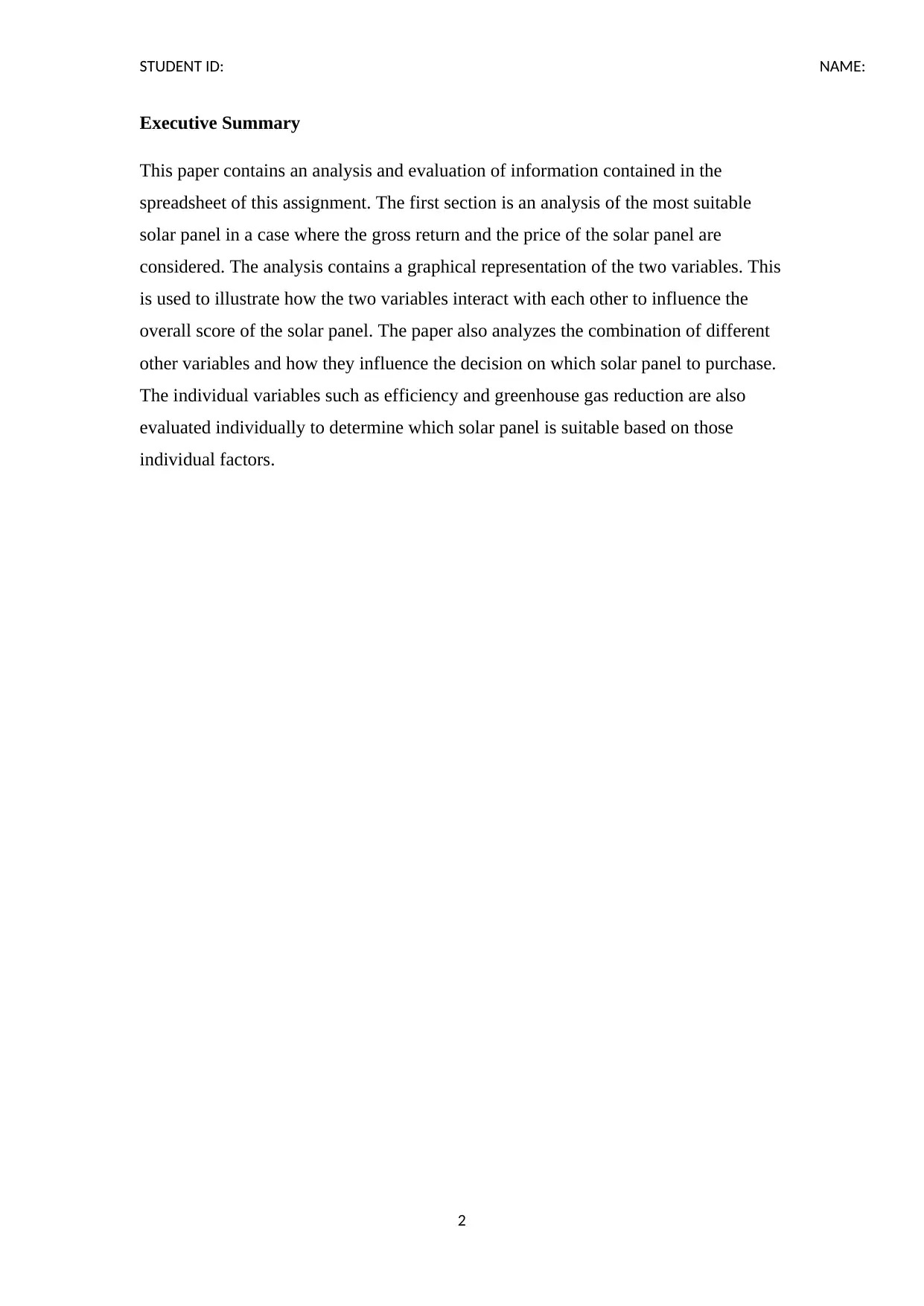
STUDENT ID: NAME:
Executive Summary
This paper contains an analysis and evaluation of information contained in the
spreadsheet of this assignment. The first section is an analysis of the most suitable
solar panel in a case where the gross return and the price of the solar panel are
considered. The analysis contains a graphical representation of the two variables. This
is used to illustrate how the two variables interact with each other to influence the
overall score of the solar panel. The paper also analyzes the combination of different
other variables and how they influence the decision on which solar panel to purchase.
The individual variables such as efficiency and greenhouse gas reduction are also
evaluated individually to determine which solar panel is suitable based on those
individual factors.
2
Executive Summary
This paper contains an analysis and evaluation of information contained in the
spreadsheet of this assignment. The first section is an analysis of the most suitable
solar panel in a case where the gross return and the price of the solar panel are
considered. The analysis contains a graphical representation of the two variables. This
is used to illustrate how the two variables interact with each other to influence the
overall score of the solar panel. The paper also analyzes the combination of different
other variables and how they influence the decision on which solar panel to purchase.
The individual variables such as efficiency and greenhouse gas reduction are also
evaluated individually to determine which solar panel is suitable based on those
individual factors.
2
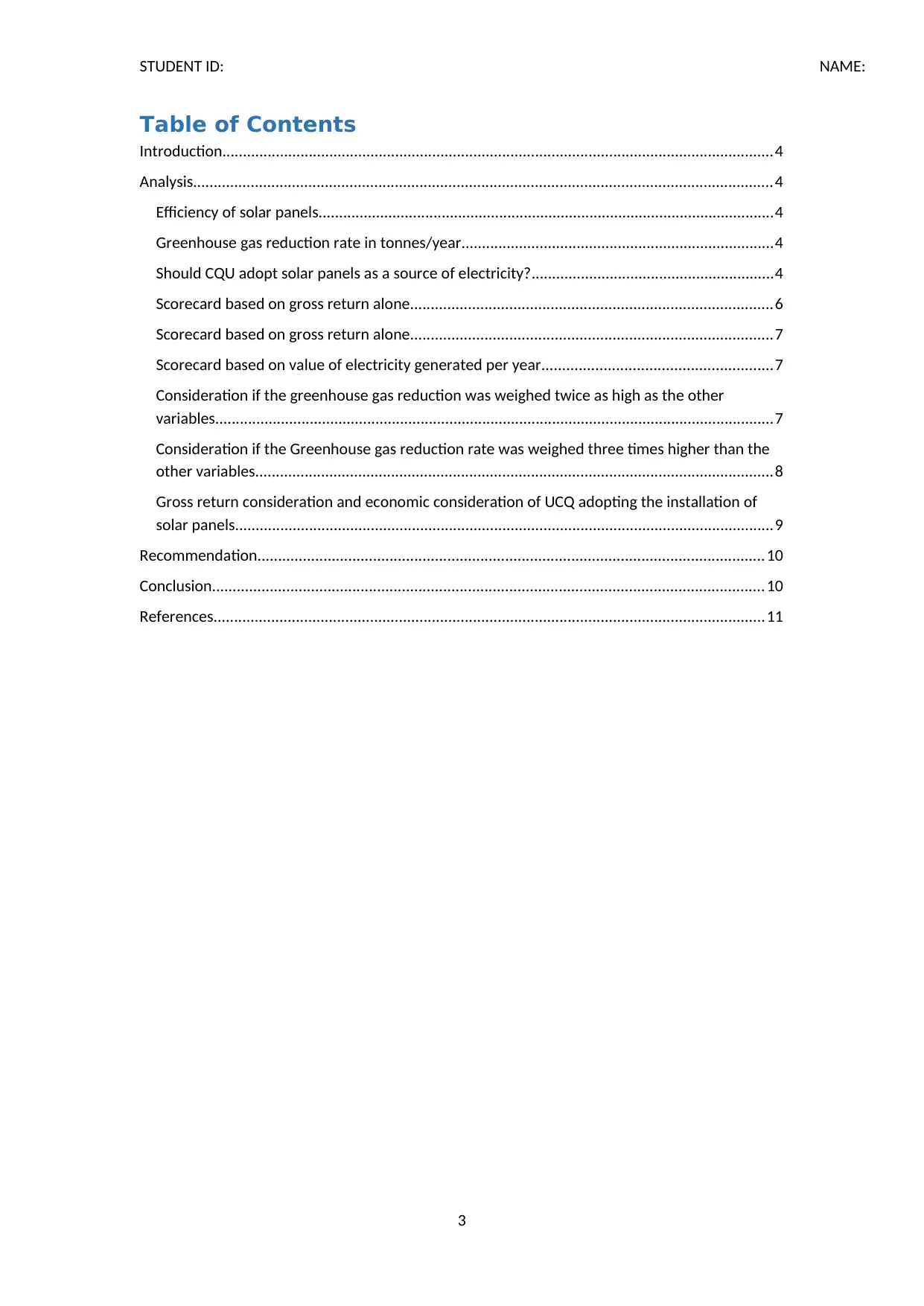
STUDENT ID: NAME:
Table of Contents
Introduction......................................................................................................................................4
Analysis.............................................................................................................................................4
Efficiency of solar panels...............................................................................................................4
Greenhouse gas reduction rate in tonnes/year............................................................................4
Should CQU adopt solar panels as a source of electricity?...........................................................4
Scorecard based on gross return alone........................................................................................6
Scorecard based on gross return alone........................................................................................7
Scorecard based on value of electricity generated per year........................................................7
Consideration if the greenhouse gas reduction was weighed twice as high as the other
variables........................................................................................................................................7
Consideration if the Greenhouse gas reduction rate was weighed three times higher than the
other variables..............................................................................................................................8
Gross return consideration and economic consideration of UCQ adopting the installation of
solar panels...................................................................................................................................9
Recommendation...........................................................................................................................10
Conclusion...................................................................................................................................... 10
References......................................................................................................................................11
3
Table of Contents
Introduction......................................................................................................................................4
Analysis.............................................................................................................................................4
Efficiency of solar panels...............................................................................................................4
Greenhouse gas reduction rate in tonnes/year............................................................................4
Should CQU adopt solar panels as a source of electricity?...........................................................4
Scorecard based on gross return alone........................................................................................6
Scorecard based on gross return alone........................................................................................7
Scorecard based on value of electricity generated per year........................................................7
Consideration if the greenhouse gas reduction was weighed twice as high as the other
variables........................................................................................................................................7
Consideration if the Greenhouse gas reduction rate was weighed three times higher than the
other variables..............................................................................................................................8
Gross return consideration and economic consideration of UCQ adopting the installation of
solar panels...................................................................................................................................9
Recommendation...........................................................................................................................10
Conclusion...................................................................................................................................... 10
References......................................................................................................................................11
3
⊘ This is a preview!⊘
Do you want full access?
Subscribe today to unlock all pages.

Trusted by 1+ million students worldwide
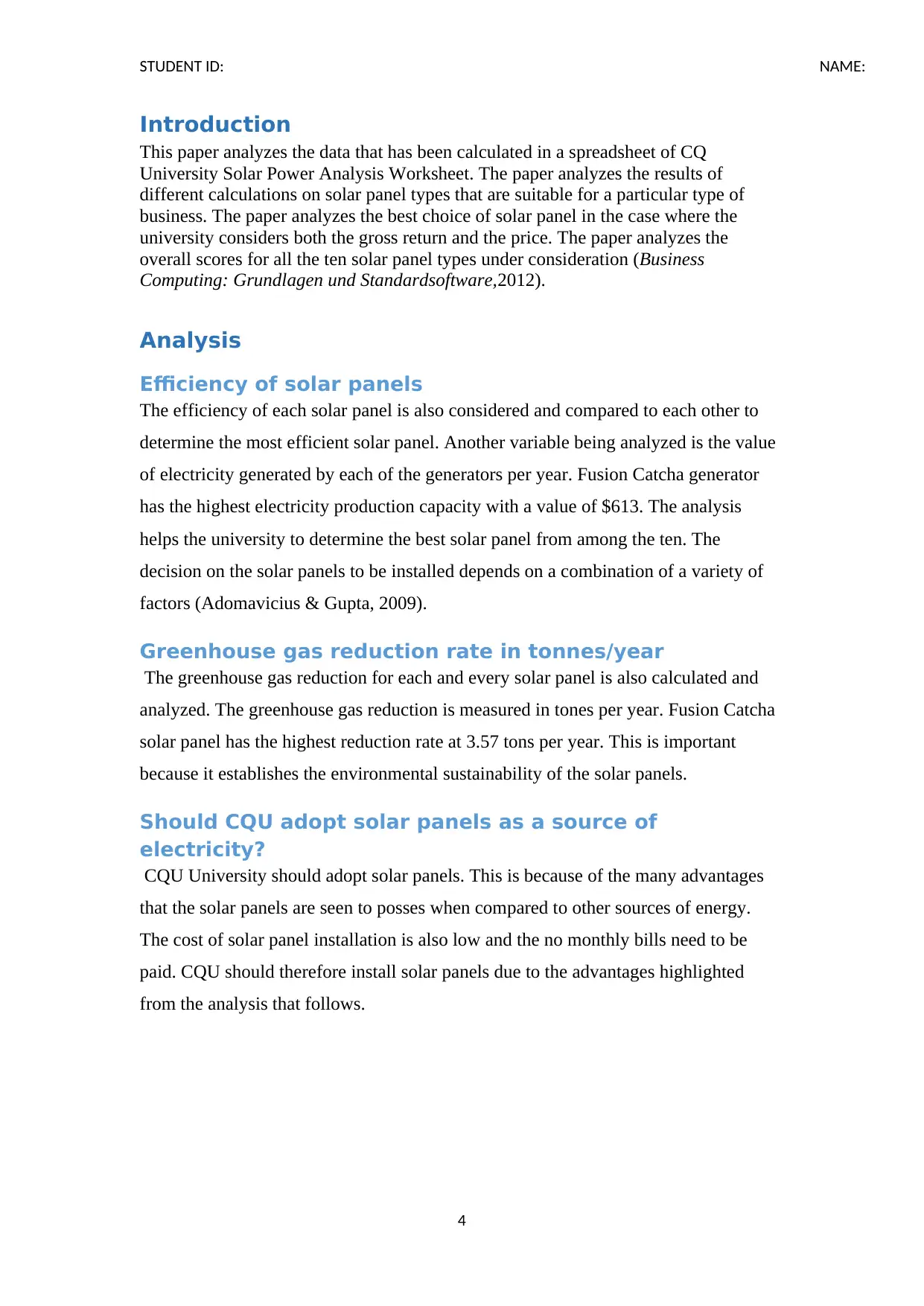
STUDENT ID: NAME:
Introduction
This paper analyzes the data that has been calculated in a spreadsheet of CQ
University Solar Power Analysis Worksheet. The paper analyzes the results of
different calculations on solar panel types that are suitable for a particular type of
business. The paper analyzes the best choice of solar panel in the case where the
university considers both the gross return and the price. The paper analyzes the
overall scores for all the ten solar panel types under consideration (Business
Computing: Grundlagen und Standardsoftware,2012).
Analysis
Efficiency of solar panels
The efficiency of each solar panel is also considered and compared to each other to
determine the most efficient solar panel. Another variable being analyzed is the value
of electricity generated by each of the generators per year. Fusion Catcha generator
has the highest electricity production capacity with a value of $613. The analysis
helps the university to determine the best solar panel from among the ten. The
decision on the solar panels to be installed depends on a combination of a variety of
factors (Adomavicius & Gupta, 2009).
Greenhouse gas reduction rate in tonnes/year
The greenhouse gas reduction for each and every solar panel is also calculated and
analyzed. The greenhouse gas reduction is measured in tones per year. Fusion Catcha
solar panel has the highest reduction rate at 3.57 tons per year. This is important
because it establishes the environmental sustainability of the solar panels.
Should CQU adopt solar panels as a source of
electricity?
CQU University should adopt solar panels. This is because of the many advantages
that the solar panels are seen to posses when compared to other sources of energy.
The cost of solar panel installation is also low and the no monthly bills need to be
paid. CQU should therefore install solar panels due to the advantages highlighted
from the analysis that follows.
4
Introduction
This paper analyzes the data that has been calculated in a spreadsheet of CQ
University Solar Power Analysis Worksheet. The paper analyzes the results of
different calculations on solar panel types that are suitable for a particular type of
business. The paper analyzes the best choice of solar panel in the case where the
university considers both the gross return and the price. The paper analyzes the
overall scores for all the ten solar panel types under consideration (Business
Computing: Grundlagen und Standardsoftware,2012).
Analysis
Efficiency of solar panels
The efficiency of each solar panel is also considered and compared to each other to
determine the most efficient solar panel. Another variable being analyzed is the value
of electricity generated by each of the generators per year. Fusion Catcha generator
has the highest electricity production capacity with a value of $613. The analysis
helps the university to determine the best solar panel from among the ten. The
decision on the solar panels to be installed depends on a combination of a variety of
factors (Adomavicius & Gupta, 2009).
Greenhouse gas reduction rate in tonnes/year
The greenhouse gas reduction for each and every solar panel is also calculated and
analyzed. The greenhouse gas reduction is measured in tones per year. Fusion Catcha
solar panel has the highest reduction rate at 3.57 tons per year. This is important
because it establishes the environmental sustainability of the solar panels.
Should CQU adopt solar panels as a source of
electricity?
CQU University should adopt solar panels. This is because of the many advantages
that the solar panels are seen to posses when compared to other sources of energy.
The cost of solar panel installation is also low and the no monthly bills need to be
paid. CQU should therefore install solar panels due to the advantages highlighted
from the analysis that follows.
4
Paraphrase This Document
Need a fresh take? Get an instant paraphrase of this document with our AI Paraphraser
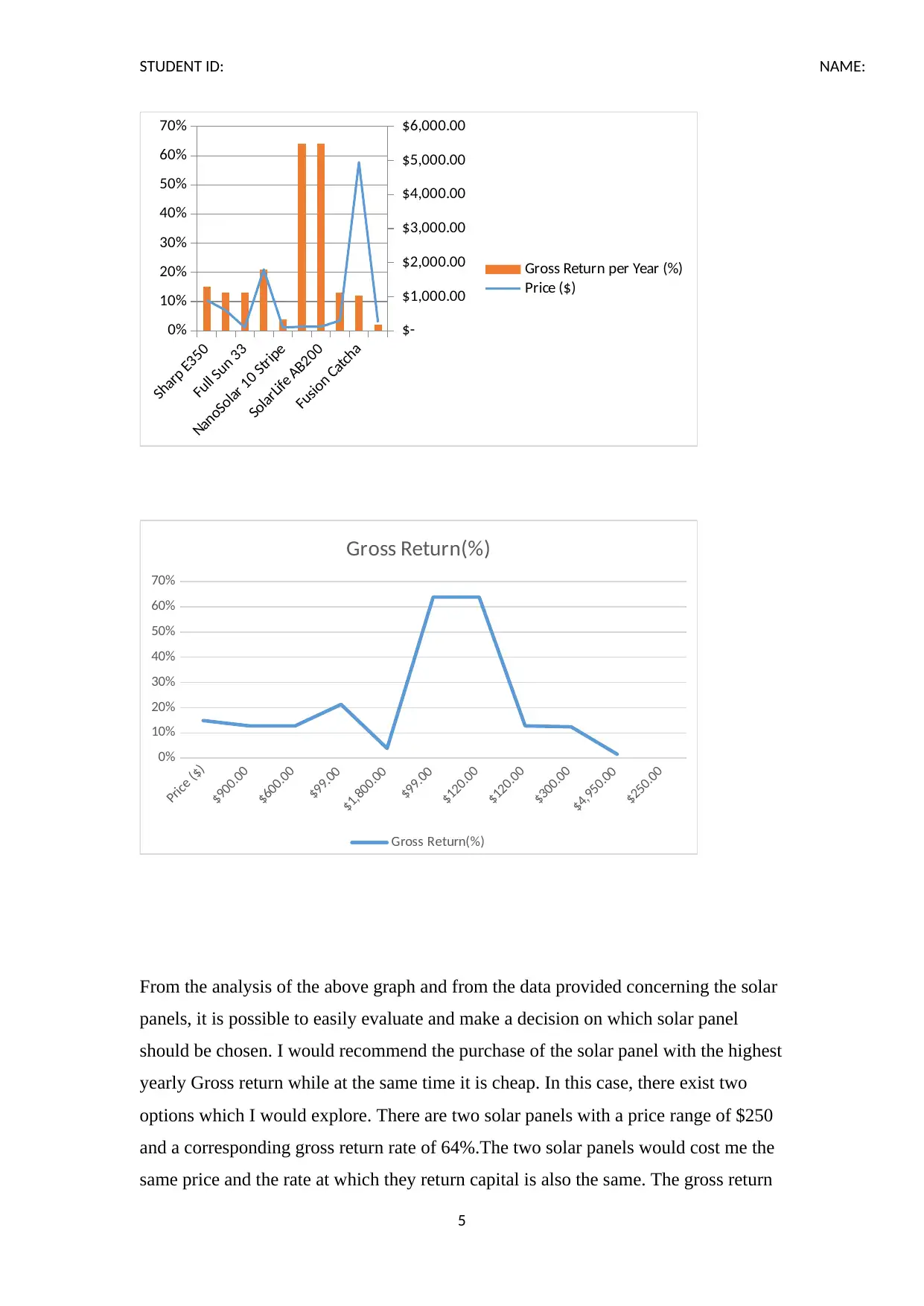
STUDENT ID: NAME:
Sharp E350
Full Sun 33
NanoSolar 10 Stripe
SolarLife AB200
Fusion Catcha
0%
10%
20%
30%
40%
50%
60%
70%
$-
$1,000.00
$2,000.00
$3,000.00
$4,000.00
$5,000.00
$6,000.00
Gross Return per Year (%)
Price ($)
Price ($)
$900.00
$600.00
$99.00
$1,800.00
$99.00
$120.00
$120.00
$300.00
$4,950.00
$250.00
0%
10%
20%
30%
40%
50%
60%
70%
Gross Return(%)
Gross Return(%)
From the analysis of the above graph and from the data provided concerning the solar
panels, it is possible to easily evaluate and make a decision on which solar panel
should be chosen. I would recommend the purchase of the solar panel with the highest
yearly Gross return while at the same time it is cheap. In this case, there exist two
options which I would explore. There are two solar panels with a price range of $250
and a corresponding gross return rate of 64%.The two solar panels would cost me the
same price and the rate at which they return capital is also the same. The gross return
5
Sharp E350
Full Sun 33
NanoSolar 10 Stripe
SolarLife AB200
Fusion Catcha
0%
10%
20%
30%
40%
50%
60%
70%
$-
$1,000.00
$2,000.00
$3,000.00
$4,000.00
$5,000.00
$6,000.00
Gross Return per Year (%)
Price ($)
Price ($)
$900.00
$600.00
$99.00
$1,800.00
$99.00
$120.00
$120.00
$300.00
$4,950.00
$250.00
0%
10%
20%
30%
40%
50%
60%
70%
Gross Return(%)
Gross Return(%)
From the analysis of the above graph and from the data provided concerning the solar
panels, it is possible to easily evaluate and make a decision on which solar panel
should be chosen. I would recommend the purchase of the solar panel with the highest
yearly Gross return while at the same time it is cheap. In this case, there exist two
options which I would explore. There are two solar panels with a price range of $250
and a corresponding gross return rate of 64%.The two solar panels would cost me the
same price and the rate at which they return capital is also the same. The gross return
5
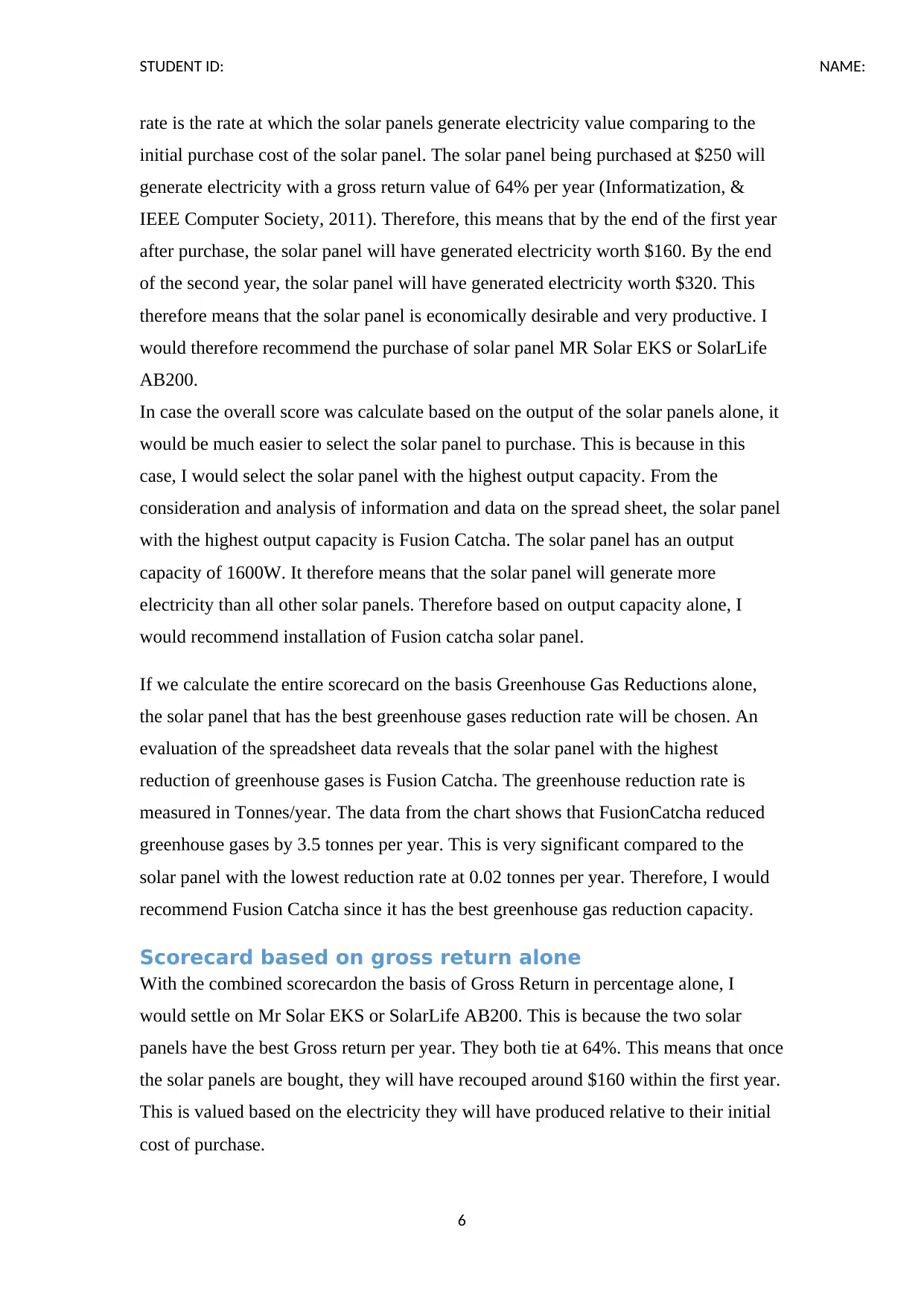
STUDENT ID: NAME:
rate is the rate at which the solar panels generate electricity value comparing to the
initial purchase cost of the solar panel. The solar panel being purchased at $250 will
generate electricity with a gross return value of 64% per year (Informatization, &
IEEE Computer Society, 2011). Therefore, this means that by the end of the first year
after purchase, the solar panel will have generated electricity worth $160. By the end
of the second year, the solar panel will have generated electricity worth $320. This
therefore means that the solar panel is economically desirable and very productive. I
would therefore recommend the purchase of solar panel MR Solar EKS or SolarLife
AB200.
In case the overall score was calculate based on the output of the solar panels alone, it
would be much easier to select the solar panel to purchase. This is because in this
case, I would select the solar panel with the highest output capacity. From the
consideration and analysis of information and data on the spread sheet, the solar panel
with the highest output capacity is Fusion Catcha. The solar panel has an output
capacity of 1600W. It therefore means that the solar panel will generate more
electricity than all other solar panels. Therefore based on output capacity alone, I
would recommend installation of Fusion catcha solar panel.
If we calculate the entire scorecard on the basis Greenhouse Gas Reductions alone,
the solar panel that has the best greenhouse gases reduction rate will be chosen. An
evaluation of the spreadsheet data reveals that the solar panel with the highest
reduction of greenhouse gases is Fusion Catcha. The greenhouse reduction rate is
measured in Tonnes/year. The data from the chart shows that FusionCatcha reduced
greenhouse gases by 3.5 tonnes per year. This is very significant compared to the
solar panel with the lowest reduction rate at 0.02 tonnes per year. Therefore, I would
recommend Fusion Catcha since it has the best greenhouse gas reduction capacity.
Scorecard based on gross return alone
With the combined scorecardon the basis of Gross Return in percentage alone, I
would settle on Mr Solar EKS or SolarLife AB200. This is because the two solar
panels have the best Gross return per year. They both tie at 64%. This means that once
the solar panels are bought, they will have recouped around $160 within the first year.
This is valued based on the electricity they will have produced relative to their initial
cost of purchase.
6
rate is the rate at which the solar panels generate electricity value comparing to the
initial purchase cost of the solar panel. The solar panel being purchased at $250 will
generate electricity with a gross return value of 64% per year (Informatization, &
IEEE Computer Society, 2011). Therefore, this means that by the end of the first year
after purchase, the solar panel will have generated electricity worth $160. By the end
of the second year, the solar panel will have generated electricity worth $320. This
therefore means that the solar panel is economically desirable and very productive. I
would therefore recommend the purchase of solar panel MR Solar EKS or SolarLife
AB200.
In case the overall score was calculate based on the output of the solar panels alone, it
would be much easier to select the solar panel to purchase. This is because in this
case, I would select the solar panel with the highest output capacity. From the
consideration and analysis of information and data on the spread sheet, the solar panel
with the highest output capacity is Fusion Catcha. The solar panel has an output
capacity of 1600W. It therefore means that the solar panel will generate more
electricity than all other solar panels. Therefore based on output capacity alone, I
would recommend installation of Fusion catcha solar panel.
If we calculate the entire scorecard on the basis Greenhouse Gas Reductions alone,
the solar panel that has the best greenhouse gases reduction rate will be chosen. An
evaluation of the spreadsheet data reveals that the solar panel with the highest
reduction of greenhouse gases is Fusion Catcha. The greenhouse reduction rate is
measured in Tonnes/year. The data from the chart shows that FusionCatcha reduced
greenhouse gases by 3.5 tonnes per year. This is very significant compared to the
solar panel with the lowest reduction rate at 0.02 tonnes per year. Therefore, I would
recommend Fusion Catcha since it has the best greenhouse gas reduction capacity.
Scorecard based on gross return alone
With the combined scorecardon the basis of Gross Return in percentage alone, I
would settle on Mr Solar EKS or SolarLife AB200. This is because the two solar
panels have the best Gross return per year. They both tie at 64%. This means that once
the solar panels are bought, they will have recouped around $160 within the first year.
This is valued based on the electricity they will have produced relative to their initial
cost of purchase.
6
⊘ This is a preview!⊘
Do you want full access?
Subscribe today to unlock all pages.

Trusted by 1+ million students worldwide
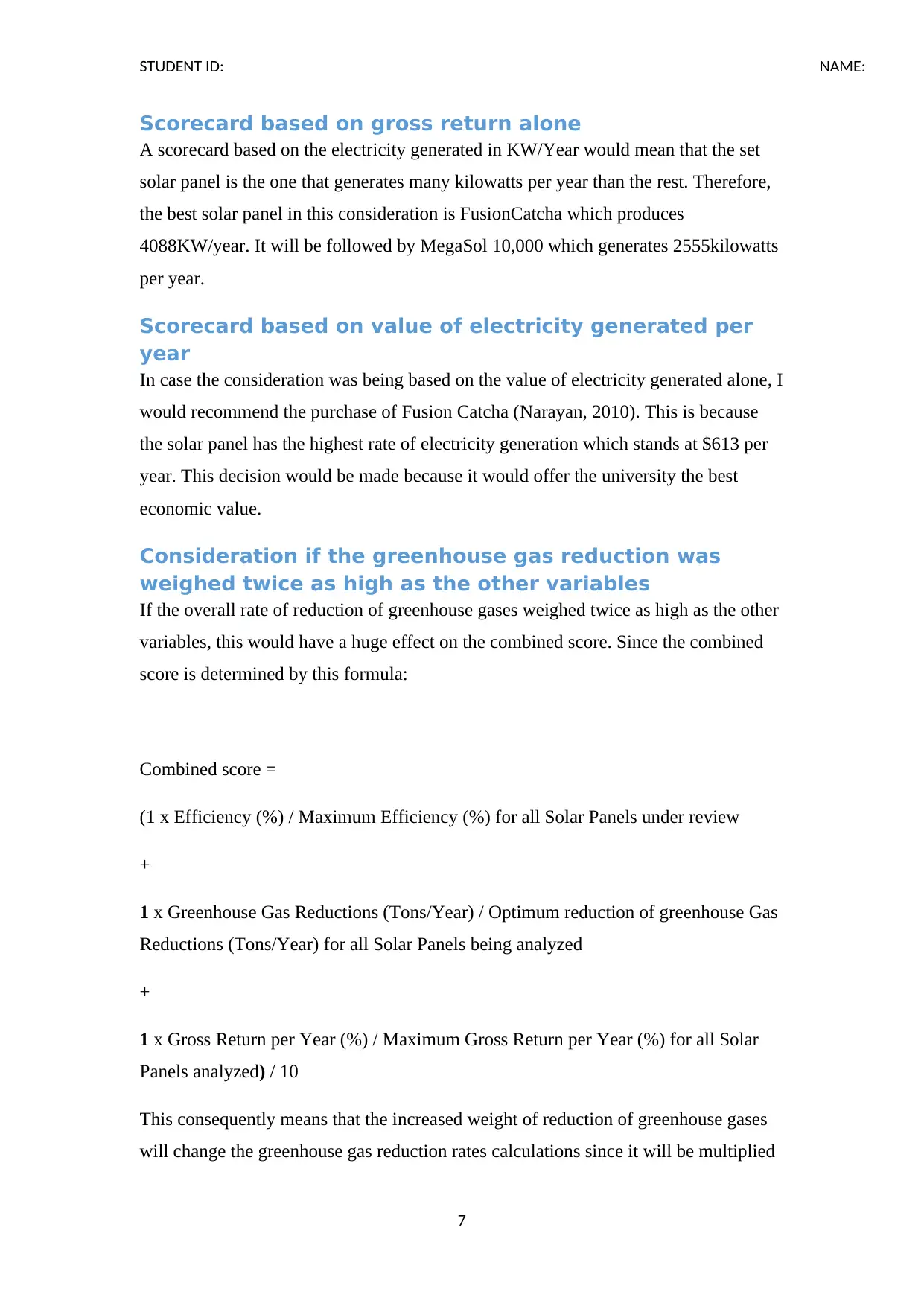
STUDENT ID: NAME:
Scorecard based on gross return alone
A scorecard based on the electricity generated in KW/Year would mean that the set
solar panel is the one that generates many kilowatts per year than the rest. Therefore,
the best solar panel in this consideration is FusionCatcha which produces
4088KW/year. It will be followed by MegaSol 10,000 which generates 2555kilowatts
per year.
Scorecard based on value of electricity generated per
year
In case the consideration was being based on the value of electricity generated alone, I
would recommend the purchase of Fusion Catcha (Narayan, 2010). This is because
the solar panel has the highest rate of electricity generation which stands at $613 per
year. This decision would be made because it would offer the university the best
economic value.
Consideration if the greenhouse gas reduction was
weighed twice as high as the other variables
If the overall rate of reduction of greenhouse gases weighed twice as high as the other
variables, this would have a huge effect on the combined score. Since the combined
score is determined by this formula:
Combined score =
(1 x Efficiency (%) / Maximum Efficiency (%) for all Solar Panels under review
+
1 x Greenhouse Gas Reductions (Tons/Year) / Optimum reduction of greenhouse Gas
Reductions (Tons/Year) for all Solar Panels being analyzed
+
1 x Gross Return per Year (%) / Maximum Gross Return per Year (%) for all Solar
Panels analyzed) / 10
This consequently means that the increased weight of reduction of greenhouse gases
will change the greenhouse gas reduction rates calculations since it will be multiplied
7
Scorecard based on gross return alone
A scorecard based on the electricity generated in KW/Year would mean that the set
solar panel is the one that generates many kilowatts per year than the rest. Therefore,
the best solar panel in this consideration is FusionCatcha which produces
4088KW/year. It will be followed by MegaSol 10,000 which generates 2555kilowatts
per year.
Scorecard based on value of electricity generated per
year
In case the consideration was being based on the value of electricity generated alone, I
would recommend the purchase of Fusion Catcha (Narayan, 2010). This is because
the solar panel has the highest rate of electricity generation which stands at $613 per
year. This decision would be made because it would offer the university the best
economic value.
Consideration if the greenhouse gas reduction was
weighed twice as high as the other variables
If the overall rate of reduction of greenhouse gases weighed twice as high as the other
variables, this would have a huge effect on the combined score. Since the combined
score is determined by this formula:
Combined score =
(1 x Efficiency (%) / Maximum Efficiency (%) for all Solar Panels under review
+
1 x Greenhouse Gas Reductions (Tons/Year) / Optimum reduction of greenhouse Gas
Reductions (Tons/Year) for all Solar Panels being analyzed
+
1 x Gross Return per Year (%) / Maximum Gross Return per Year (%) for all Solar
Panels analyzed) / 10
This consequently means that the increased weight of reduction of greenhouse gases
will change the greenhouse gas reduction rates calculations since it will be multiplied
7
Paraphrase This Document
Need a fresh take? Get an instant paraphrase of this document with our AI Paraphraser
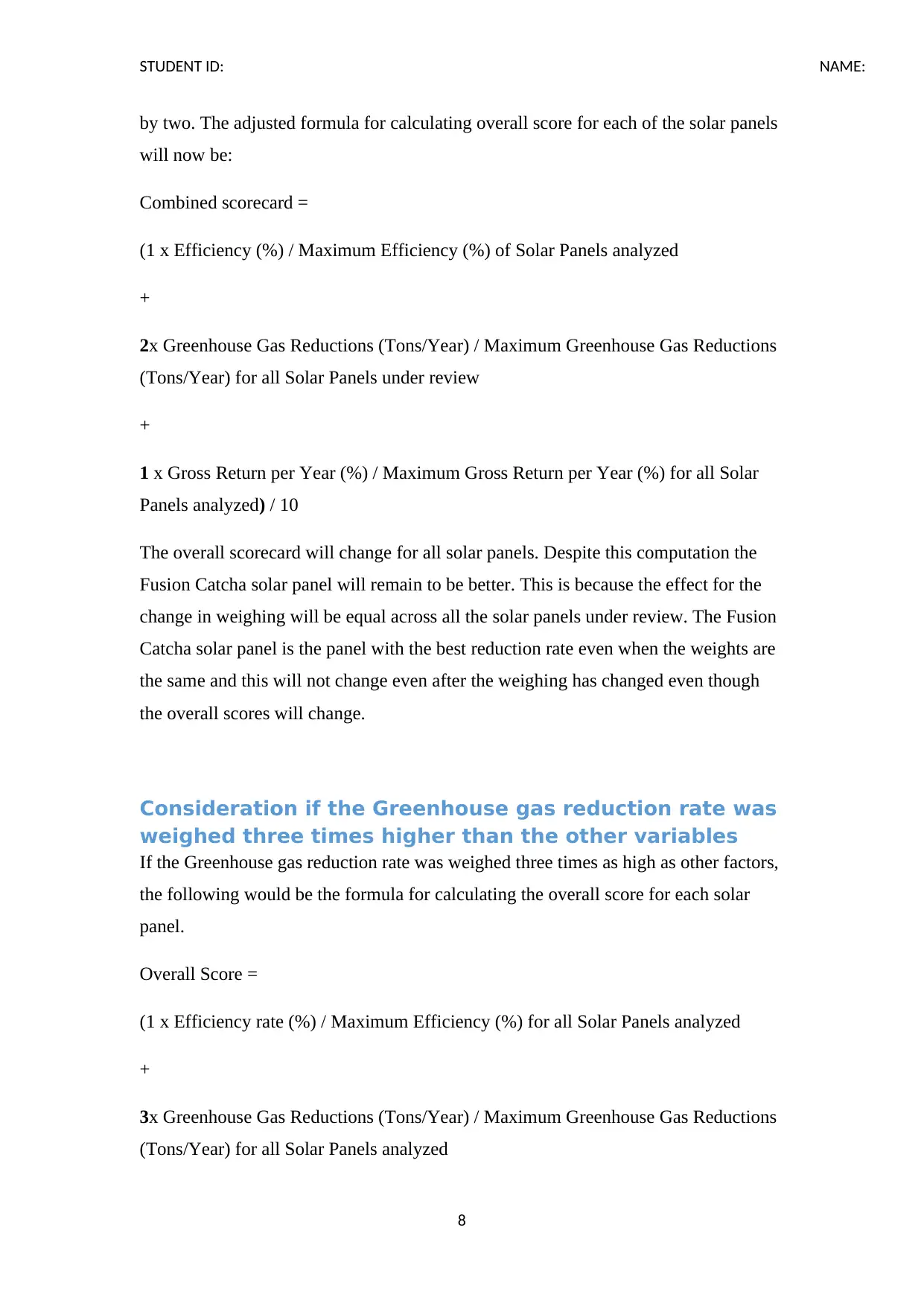
STUDENT ID: NAME:
by two. The adjusted formula for calculating overall score for each of the solar panels
will now be:
Combined scorecard =
(1 x Efficiency (%) / Maximum Efficiency (%) of Solar Panels analyzed
+
2x Greenhouse Gas Reductions (Tons/Year) / Maximum Greenhouse Gas Reductions
(Tons/Year) for all Solar Panels under review
+
1 x Gross Return per Year (%) / Maximum Gross Return per Year (%) for all Solar
Panels analyzed) / 10
The overall scorecard will change for all solar panels. Despite this computation the
Fusion Catcha solar panel will remain to be better. This is because the effect for the
change in weighing will be equal across all the solar panels under review. The Fusion
Catcha solar panel is the panel with the best reduction rate even when the weights are
the same and this will not change even after the weighing has changed even though
the overall scores will change.
Consideration if the Greenhouse gas reduction rate was
weighed three times higher than the other variables
If the Greenhouse gas reduction rate was weighed three times as high as other factors,
the following would be the formula for calculating the overall score for each solar
panel.
Overall Score =
(1 x Efficiency rate (%) / Maximum Efficiency (%) for all Solar Panels analyzed
+
3x Greenhouse Gas Reductions (Tons/Year) / Maximum Greenhouse Gas Reductions
(Tons/Year) for all Solar Panels analyzed
8
by two. The adjusted formula for calculating overall score for each of the solar panels
will now be:
Combined scorecard =
(1 x Efficiency (%) / Maximum Efficiency (%) of Solar Panels analyzed
+
2x Greenhouse Gas Reductions (Tons/Year) / Maximum Greenhouse Gas Reductions
(Tons/Year) for all Solar Panels under review
+
1 x Gross Return per Year (%) / Maximum Gross Return per Year (%) for all Solar
Panels analyzed) / 10
The overall scorecard will change for all solar panels. Despite this computation the
Fusion Catcha solar panel will remain to be better. This is because the effect for the
change in weighing will be equal across all the solar panels under review. The Fusion
Catcha solar panel is the panel with the best reduction rate even when the weights are
the same and this will not change even after the weighing has changed even though
the overall scores will change.
Consideration if the Greenhouse gas reduction rate was
weighed three times higher than the other variables
If the Greenhouse gas reduction rate was weighed three times as high as other factors,
the following would be the formula for calculating the overall score for each solar
panel.
Overall Score =
(1 x Efficiency rate (%) / Maximum Efficiency (%) for all Solar Panels analyzed
+
3x Greenhouse Gas Reductions (Tons/Year) / Maximum Greenhouse Gas Reductions
(Tons/Year) for all Solar Panels analyzed
8
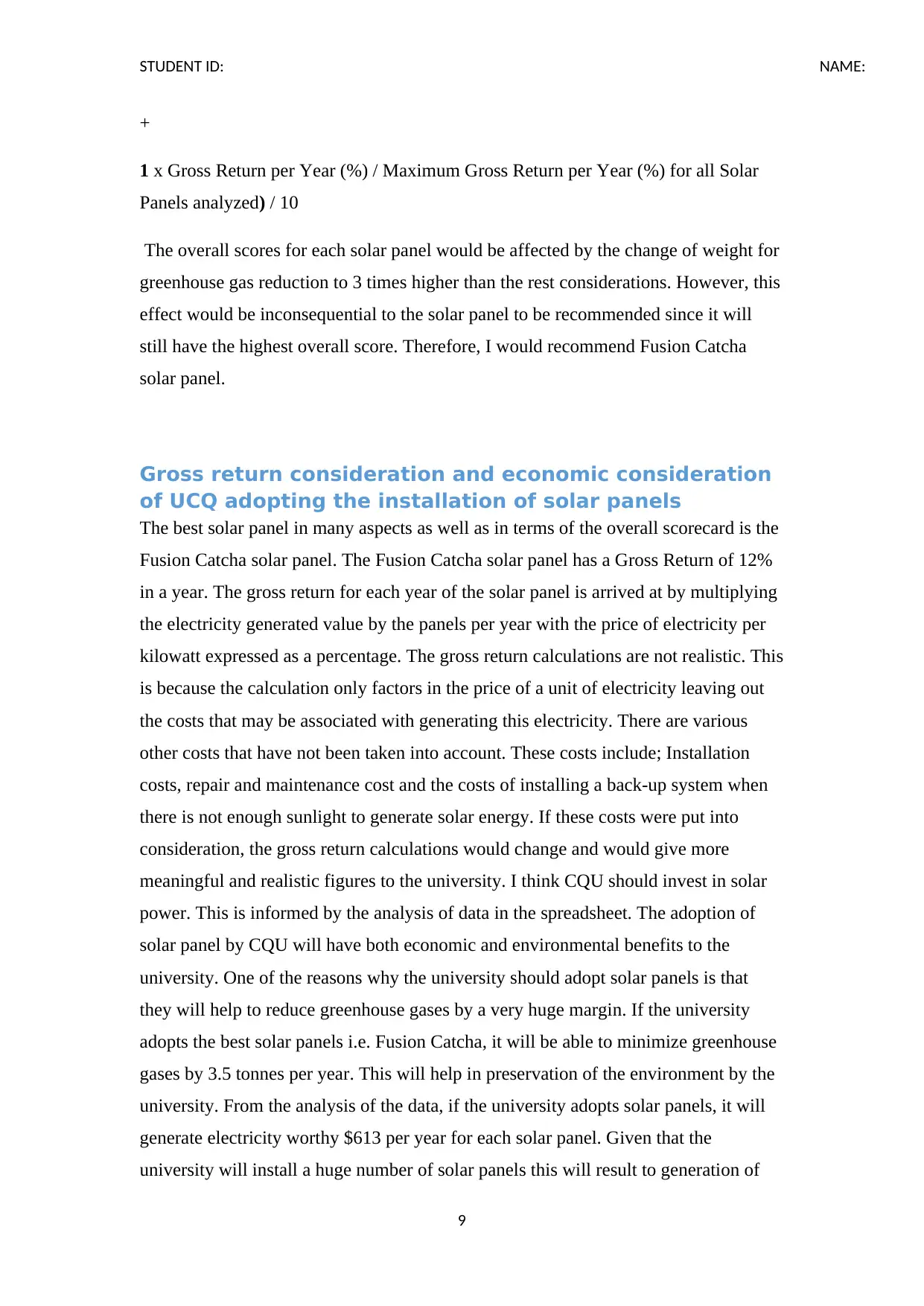
STUDENT ID: NAME:
+
1 x Gross Return per Year (%) / Maximum Gross Return per Year (%) for all Solar
Panels analyzed) / 10
The overall scores for each solar panel would be affected by the change of weight for
greenhouse gas reduction to 3 times higher than the rest considerations. However, this
effect would be inconsequential to the solar panel to be recommended since it will
still have the highest overall score. Therefore, I would recommend Fusion Catcha
solar panel.
Gross return consideration and economic consideration
of UCQ adopting the installation of solar panels
The best solar panel in many aspects as well as in terms of the overall scorecard is the
Fusion Catcha solar panel. The Fusion Catcha solar panel has a Gross Return of 12%
in a year. The gross return for each year of the solar panel is arrived at by multiplying
the electricity generated value by the panels per year with the price of electricity per
kilowatt expressed as a percentage. The gross return calculations are not realistic. This
is because the calculation only factors in the price of a unit of electricity leaving out
the costs that may be associated with generating this electricity. There are various
other costs that have not been taken into account. These costs include; Installation
costs, repair and maintenance cost and the costs of installing a back-up system when
there is not enough sunlight to generate solar energy. If these costs were put into
consideration, the gross return calculations would change and would give more
meaningful and realistic figures to the university. I think CQU should invest in solar
power. This is informed by the analysis of data in the spreadsheet. The adoption of
solar panel by CQU will have both economic and environmental benefits to the
university. One of the reasons why the university should adopt solar panels is that
they will help to reduce greenhouse gases by a very huge margin. If the university
adopts the best solar panels i.e. Fusion Catcha, it will be able to minimize greenhouse
gases by 3.5 tonnes per year. This will help in preservation of the environment by the
university. From the analysis of the data, if the university adopts solar panels, it will
generate electricity worthy $613 per year for each solar panel. Given that the
university will install a huge number of solar panels this will result to generation of
9
+
1 x Gross Return per Year (%) / Maximum Gross Return per Year (%) for all Solar
Panels analyzed) / 10
The overall scores for each solar panel would be affected by the change of weight for
greenhouse gas reduction to 3 times higher than the rest considerations. However, this
effect would be inconsequential to the solar panel to be recommended since it will
still have the highest overall score. Therefore, I would recommend Fusion Catcha
solar panel.
Gross return consideration and economic consideration
of UCQ adopting the installation of solar panels
The best solar panel in many aspects as well as in terms of the overall scorecard is the
Fusion Catcha solar panel. The Fusion Catcha solar panel has a Gross Return of 12%
in a year. The gross return for each year of the solar panel is arrived at by multiplying
the electricity generated value by the panels per year with the price of electricity per
kilowatt expressed as a percentage. The gross return calculations are not realistic. This
is because the calculation only factors in the price of a unit of electricity leaving out
the costs that may be associated with generating this electricity. There are various
other costs that have not been taken into account. These costs include; Installation
costs, repair and maintenance cost and the costs of installing a back-up system when
there is not enough sunlight to generate solar energy. If these costs were put into
consideration, the gross return calculations would change and would give more
meaningful and realistic figures to the university. I think CQU should invest in solar
power. This is informed by the analysis of data in the spreadsheet. The adoption of
solar panel by CQU will have both economic and environmental benefits to the
university. One of the reasons why the university should adopt solar panels is that
they will help to reduce greenhouse gases by a very huge margin. If the university
adopts the best solar panels i.e. Fusion Catcha, it will be able to minimize greenhouse
gases by 3.5 tonnes per year. This will help in preservation of the environment by the
university. From the analysis of the data, if the university adopts solar panels, it will
generate electricity worthy $613 per year for each solar panel. Given that the
university will install a huge number of solar panels this will result to generation of
9
⊘ This is a preview!⊘
Do you want full access?
Subscribe today to unlock all pages.

Trusted by 1+ million students worldwide
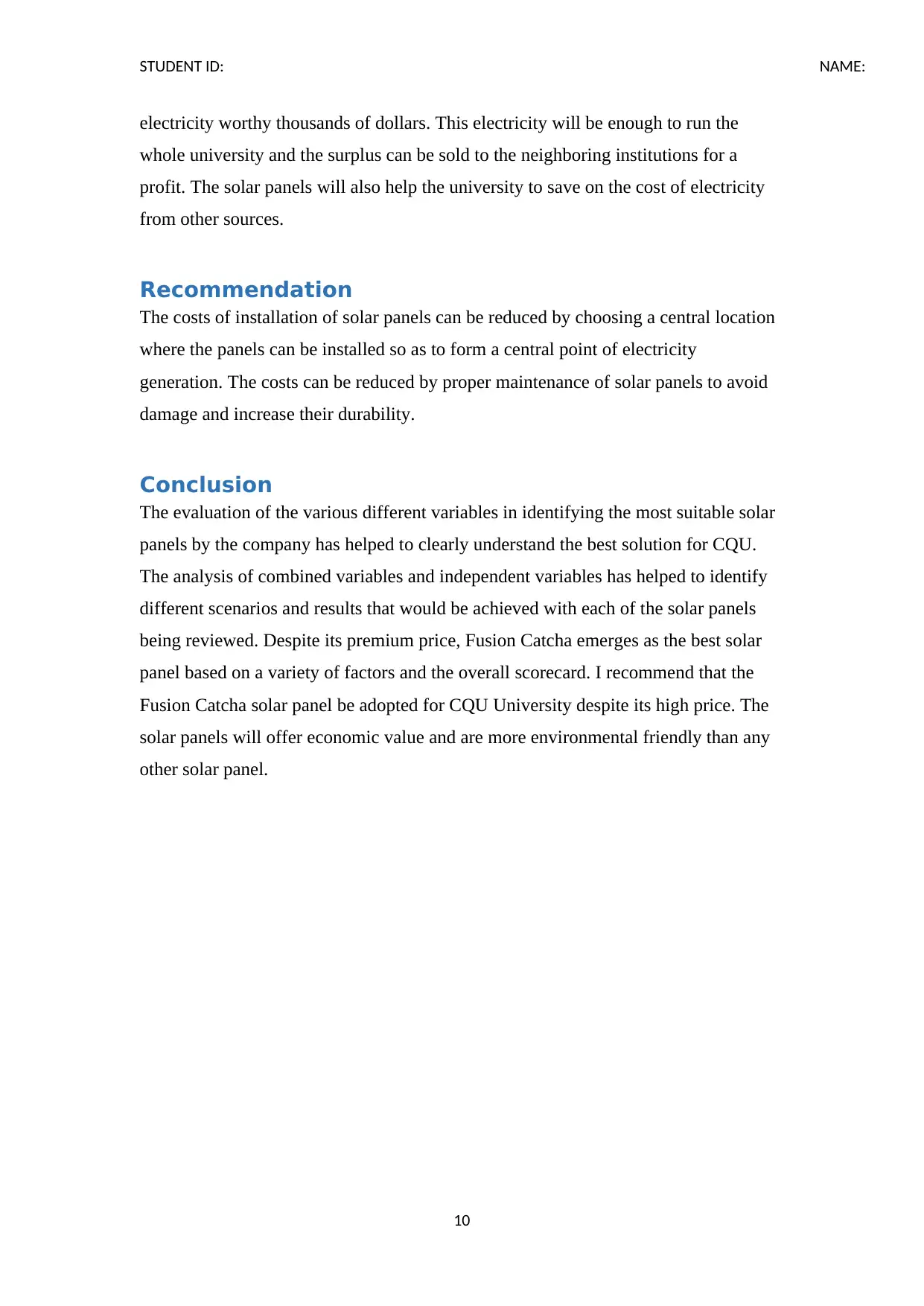
STUDENT ID: NAME:
electricity worthy thousands of dollars. This electricity will be enough to run the
whole university and the surplus can be sold to the neighboring institutions for a
profit. The solar panels will also help the university to save on the cost of electricity
from other sources.
Recommendation
The costs of installation of solar panels can be reduced by choosing a central location
where the panels can be installed so as to form a central point of electricity
generation. The costs can be reduced by proper maintenance of solar panels to avoid
damage and increase their durability.
Conclusion
The evaluation of the various different variables in identifying the most suitable solar
panels by the company has helped to clearly understand the best solution for CQU.
The analysis of combined variables and independent variables has helped to identify
different scenarios and results that would be achieved with each of the solar panels
being reviewed. Despite its premium price, Fusion Catcha emerges as the best solar
panel based on a variety of factors and the overall scorecard. I recommend that the
Fusion Catcha solar panel be adopted for CQU University despite its high price. The
solar panels will offer economic value and are more environmental friendly than any
other solar panel.
10
electricity worthy thousands of dollars. This electricity will be enough to run the
whole university and the surplus can be sold to the neighboring institutions for a
profit. The solar panels will also help the university to save on the cost of electricity
from other sources.
Recommendation
The costs of installation of solar panels can be reduced by choosing a central location
where the panels can be installed so as to form a central point of electricity
generation. The costs can be reduced by proper maintenance of solar panels to avoid
damage and increase their durability.
Conclusion
The evaluation of the various different variables in identifying the most suitable solar
panels by the company has helped to clearly understand the best solution for CQU.
The analysis of combined variables and independent variables has helped to identify
different scenarios and results that would be achieved with each of the solar panels
being reviewed. Despite its premium price, Fusion Catcha emerges as the best solar
panel based on a variety of factors and the overall scorecard. I recommend that the
Fusion Catcha solar panel be adopted for CQU University despite its high price. The
solar panels will offer economic value and are more environmental friendly than any
other solar panel.
10
Paraphrase This Document
Need a fresh take? Get an instant paraphrase of this document with our AI Paraphraser

STUDENT ID: NAME:
References
Adomavicius, G., & Gupta, A. (2009). Business computing. Bingley, UK: Emerald
Business Computing: Grundlagen und Standardsoftware. (2002). Berlin, Heidelberg:
Springer Berlin Heidelberg.
Business Computing mit SAP R/3 庐: Modellierung, Customizing und Anwendung
betriebswirtschaftlich-integrierter Gescha 庐 ftsprozesse
Business Computing: Arbeiten mit MS-Office und Internet. (2008). Berlin,
Heidelberg: Springer Berlin Heidelberg.
International Conference on Business Computing and Global Informatization, & IEEE
Computer Society. (2011). Proceedings of the 2011 International Conference
on Business Computing and Global Informatization: 29-31 July 2011,
Shanghai, China. Los Alamitos, Calif.: IEEE Computer Society.
Narayan, R. (2010). Business computing. Place of publication not identified: Centrum
Press.
11
References
Adomavicius, G., & Gupta, A. (2009). Business computing. Bingley, UK: Emerald
Business Computing: Grundlagen und Standardsoftware. (2002). Berlin, Heidelberg:
Springer Berlin Heidelberg.
Business Computing mit SAP R/3 庐: Modellierung, Customizing und Anwendung
betriebswirtschaftlich-integrierter Gescha 庐 ftsprozesse
Business Computing: Arbeiten mit MS-Office und Internet. (2008). Berlin,
Heidelberg: Springer Berlin Heidelberg.
International Conference on Business Computing and Global Informatization, & IEEE
Computer Society. (2011). Proceedings of the 2011 International Conference
on Business Computing and Global Informatization: 29-31 July 2011,
Shanghai, China. Los Alamitos, Calif.: IEEE Computer Society.
Narayan, R. (2010). Business computing. Place of publication not identified: Centrum
Press.
11
1 out of 11
Your All-in-One AI-Powered Toolkit for Academic Success.
+13062052269
info@desklib.com
Available 24*7 on WhatsApp / Email
![[object Object]](/_next/static/media/star-bottom.7253800d.svg)
Unlock your academic potential
Copyright © 2020–2025 A2Z Services. All Rights Reserved. Developed and managed by ZUCOL.

